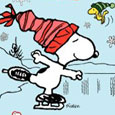Studio Ghibli (2006), Walt Disney Studios Home Entertainment (March 8, 2011), 1 disc, 75 mins, 1.85: 1 ratio, Dolby Digital 5.1 (Japanese) and 2.0 (English), Rated PG-13, Retail: $29.99
Storyboard:
A troubled boy takes up with a wise wizard, a farm lady, and a girl; and all together they face an evil wizard, in the midst of magical imbalance.
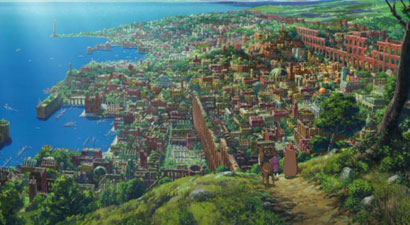
The Sweatbox Review:
Studio Ghibli founder Hayao Miyazaki has apparently long been a fan of Ursula K. Le Guin’s Earthsea series of fantasy novels. The books began as a short story published in 1964, which led to several more short stories and six books. Miyazaki had pursued the animation rights to the books for some time before Le Guin relented after seeing My Neighbor Totoro, citing what she saw as Miyazaki’s genius, and her preference for his films over Disney-style moviemaking. Miyazaki then thwarted Le Guin’s expectations when he passed the project on to his son Goro, who had never directed a film before. (This was during one of those times that Hayao Miyazaki claimed to have retired.) The somewhat rushed production wrapped up in less than nine months, about half the time it took to produce Spirited Away. The result was a film that pleased very few when it was released in Japanese theaters in 2006. Rumors flew about the senior Miyazaki’s disdain for his son’s movie, and Le Guin’s voiced her own disappointment (to put it mildly). The film even won Japan’s version of the Raspberry Award as Worst Picture, and the junior Miyazaki was recognized as Worst Director. Despite that, it did very well at the box office, placing fourth for the year in Japan. With the film now available on DVD in North America, we all have the opportunity to see it for ourselves.
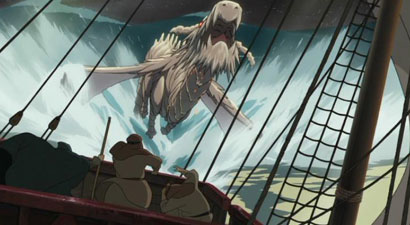
Well, as it turns out, it’s far from a disaster, but it’s not great either. I haven’t read the Earthsea books (or seen the Sci-Fi Channel miniseries, which had delayed Disney’s ability to release the film in North America earlier), but from what I’ve gathered this film is a very loose adaptation, basically taking place in the world created by Le Guin, but with many liberties taken. Despite even borrowing the title of one of the books (a short story collection)— and allegedly actually having being based largely on the third book— this is a new work unto itself, utilizing names and concepts while abandoning the original plots. It still takes place on an archipelago, as the story travels between islands in a plot that encompasses magic and mystery. It also utilizes the notion of the use of magic leading to a loss in the balance of nature. The theme of maintaining nature’s balance is a frequent theme in Ghibli movies, so the Earthsea mythos actually makes for a good fit, theoretically.
The movie itself is about… darn, I’ve forgotten already. That’s not a good sign. Just a few days after viewing it, I have little memory of it. Let me look back at my notes…
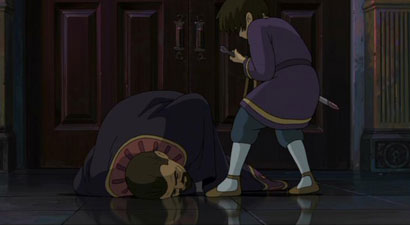
Oh, right. The story begins with a ship at sea in a storm, and the bad omen of two dragons fighting in the sky overhead. Word of this reaches the palace, where the king is also mulling over the difficulties of drought and disease in the kingdom. We learn that dragons and humans we once one, but separated when dragons chose freedom and humans chose possessions. It is suggested that the kingdom’s numerous problems and the bad omens being seen are signs of nature being out of balance. And then, the king’s son, who we had been told was behaving oddly, steals his dad’s sword and kills him. I was never clear on why that happened, but I guess he went mad from nature being out of balance. Or something like that. I guess.
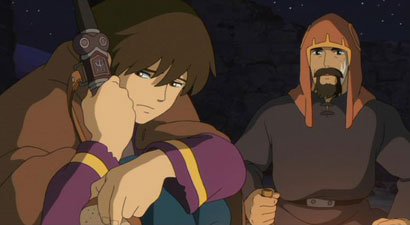
Somewhat distraught over his unmotivated patricide, young Prince Arren flees the kingdom and is later aided by an “archmage” named Sparrowhawk (fashioned after “Ged” from the books). They head into the unfortunately named city of Hort Town, and Arren has the opportunity to save a girl who is trying to escape from slave traders before being captured and rescued himself. He and Sparrowhawk then go to a farm to stay with Sparrowhawk’s lady friend Tenar, who turns out to be taking care of the same young girl, who we now learn is named Therru. Meanwhile, the head slaver has told his boss Lord Cob of the arrival of Sparrowhawk in Hort Town, which intrigues Cob immensely. From there, Cob orchestrates a plan to bring Sparrowhawk to him in order to learn wizard things, we naturally find out that Lord Cob’s behaviour is the reason behind all the portents of doom, Arren duels with another part of himself (not really explained) before being taken over by Cob, eternal life gets bantered about, someone turns into a dragon (I think), and… I think I kind of liked it, or at least parts of it. Then I forgot everything I’d seen. Except that Cob was drawn as a woman, despite having the voice of Willem Dafoe. (Weird!) And here we are.

Given others’ critical response to this movie, I’ve forgiven myself for not understanding everything. With other Japanese films, I often find myself feeling a bit lost due to a combination of cultural differences and poor storytelling, but here at least it seems I’m not alone in my bemusement. I’ve never been comfortable with tales of mysticism and their arbitrary rules, and it sure doesn’t help when things aren’t being explained to the viewer. I read Le Guin’s own comments on the film, and found she was equally confused about many of the movie’s plot points, so there you go. When the author of the original work is confused, you know you’re in trouble.
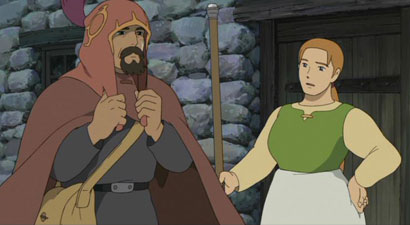
Beyond the script, there are visual problems. Sometimes when there are script issues, you can at least be swept away by stunning animation. For many of us, much can be forgiven when beautiful eye candy is on display. Unfortunately, Tales From Earthsea also fails in this respect. There are still some really nice moments, and I especially liked the flight of the dragons, but overall the movie’s look is pretty conventional and tame. Old standbys like pans and tracking shots are just fine, but Ghibli films normally can be counted on for some breathtaking circling shots or intense action scenes, despite not being as fully animated as American features.
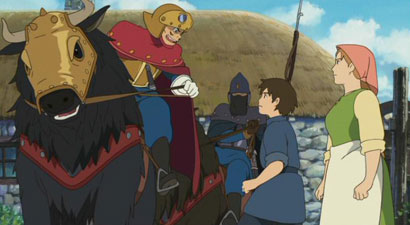
Goro does not have his father’s talent for storytelling in the animation medium, at least not yet. Too often, characters explain what we should instead be seeing. Arren is acting oddly? Nature is not in balance? These are things that should be shown in the visuals, not simply mentioned in dialog. It makes the film more awkward and obviously the work of a novice. Add that to the previously mentioned plot holes and unexplained occurrences, and you have a bit of a mess. Pacing is also an issue, though I didn’t necessarily mind the leisurely pace. It would have been more worth it, though, if the payoff was better or if we could at least have heard a joke once in a while. Quicker pacing or more of a sense of humor may have distracted me from noticing how shoddy the storytelling was.
My harsh comments come mostly from disappointment when considering what might have been, had Hayao Miyazaki steered this one himself, or given it over to a more experienced director. It’s not all bad; it’s just not as good as it could have been. There are still some neat ideas and designs, and I wasn’t actually bored with the film. I don’t mind having this on my shelf in order to keep my Ghibli collection as complete as possible, but it will be a while before I revisit it.
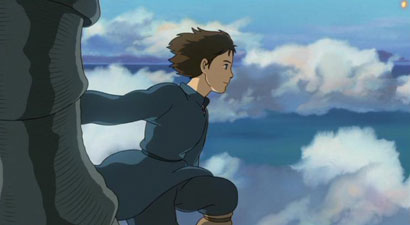
Is This Thing Loaded?
Likely owing to the film’s less-than-vaunted reputation, we get the slimmest Studio Ghibli DVD since Princess Mononoke came out over a decade ago. Disney still has the extras collected under the banner of “The World of Ghibli,” with one item each under “Behind The Studio” and “Enter The Lands.”
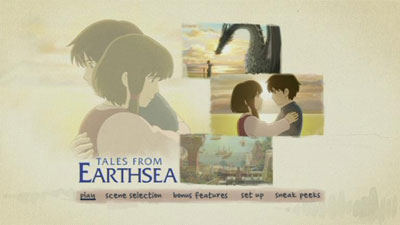
Under the first heading, we get the featurette Origins Of Earthsea (4:00), a brief selection of interviews with producer Toshio Suzuki and animation historian Charles Solomon that may enlighten you less than reading this review. The “Lands” extra is just a Studio Ghibli Trivia Challenge, in addition to previous Lands extras from other DVDs.
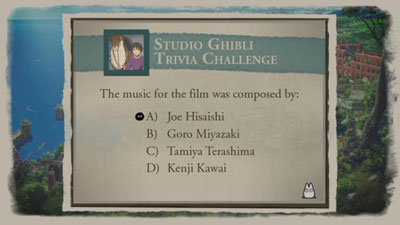
Case Study:
The single disc is held in a black keepcase, sporting a cover slip that is identical except for re-arranging images on the back cover. Like other recent Ghibli DVDs, this cover sports a gold foil spine and the cover is lightly embossed. Inside the case are two inserts, for Disney Movie rewards and Disney Blu-ray 3D.
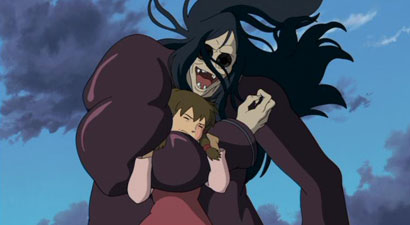
Ink And Paint:
The 1.85:1 transfer is fairly strong, even if the film’s look isn’t memorable. The print is certainly clean, and there are no major compression issues beyond a bit of shimmer when the action or the camera moves too fast— which doesn’t happen too often in this film.
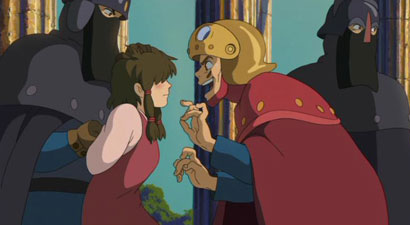
Scratch Tracks:
The Japanese Dolby Digital 5.1 track is definitely the best part of the movie. The soundtrack tries hard to make you think you’re watching something special, and at times I was actually convinced. Witness the opening scene of a ship in a storm, with all sorts of weather madness filling the room. That may have been as great as it ever got, but at least it was a great start. By comparison, the chintzy 2.0 English track has nowhere near the power or intensity, further minimizing the impact of the film. Unless you really, really hate subtitles, then go for the Japanese track.

It’s too bad that only 2.0 was used for the English track, as the voice work is quite good in some instances. I was impressed mostly by Timothy Dalton’s Sparrowhawk, and Willem Dafoe did well for the strangely androgynous Cob. On the other hand, I love Mariska Hargitay, but I don’t think her voice lent itself well to the warm and matronly Tenar.
There are two options for English subtitles— regular subtitles, and those for the hearing impaired. Subtitles are also offered in French.
Final Cut:
The reports of this film’s awfulness may have been exaggerated, but it is certainly one of the weaker Studio Ghibli efforts. Goro’s inexperience shows, and so we get a jumbled, slow-paced would-be epic that falls flat. I felt like it was grasping to find its themes, got caught up in a plot that is simplistic in theory but confusing in the details, and finally the movie ends with its most inexplicable scene yet. Video and audio are very good, particularly the Japanese audio track, while extras are pretty slim. The curious will do fine with a rental, but only Ghibli diehards will want to own it.
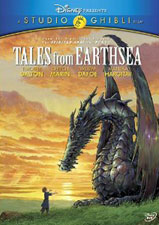 | ||
 |









